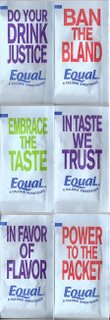 Picture this: you’re standing in a room full of strangers, not talking to a soul. You’re hoping to make at least one connection, but can’t seem to get the ball rolling. Eventually you think, “This is ridiculous. Why can’t I start a conversation with anyone?”
Picture this: you’re standing in a room full of strangers, not talking to a soul. You’re hoping to make at least one connection, but can’t seem to get the ball rolling. Eventually you think, “This is ridiculous. Why can’t I start a conversation with anyone?”
The answer to that question runs deeper than you might think.
Starting conversations not only depends on your communication skills; it’s also a function of your self-confidence. In this article, we will explore 9 common barriers that stand in your way of conversational approachability. (It’s a pretty lengthy piece, so half is here and the other half is on my website.)
BARRIER #1: I don’t want to be rejected.
This is the big one. The number one hindrance to approaching someone else: the fear of rejection.
In Triumph Over Shyness, Philip Zombardo states, “Shy people are often attracted to those who do not return the affection, which is a very painful way of creating safety.”
Yes, it can be scary. But the truth is, rejection is part of life. You can’t evade it forever. Also, assuming that you can’t handle rejection is a mistaken belief. Besides, more often than not, rejection isn’t as bad as you think. After all, what’s so bad about being rejected by someone you hardly even know? Don’t let a few no’s stand in your way of stepping up to bat again in the future.
LET ME SUGGEST THIS…
Win a few small victories first. Go to the mall and practice approaching cashiers, clerks, salespeople, kiosk operators and the like. They can’t reject you! These smaller successes will build your confidence and equip you with positive experiences to dwell upon in the future.
BARRIER #2: I don’t have anything good to say.
First of all, 93% of all conversation is nonverbal. So, don’t get too hung up on your words. Concentrate on having approachable, open body language first. Smile, don’t cross your arms, maintain open posture, keep your hands away from your face and maintain eye contact with everyone within 4-10 feet of you. Many people – even extroverts – miss the boat on this crucial component of communication.
Secondly, consider this: the only thing people can judge about you is how engaging with you makes them feel. It’s like Mother Theresa said, “People won’t remember what you said, or what you did; but they will never forget the way you made them feel.”
And finally, who says there’s a “right” thing to say all of the time? Not everything you say has to be supremely witty, brilliant or quotable. Again, the secret isn’t in what or how much you have to say, but in how you make people feel. Focus less on YOUR self, YOUR insecurities and YOUR discomfort, and more on the conversational needs of others. Be a great listener. Ask open-ended questions that begin with “What’s your experience?” and “What’s your favorite?” An increased focus on others will help you overlook your own insecurities.
LET ME SUGGEST THIS…
If you don’t think you have anything good to say, make a “Conversation Cheat Sheet” before you leave the house. Grab an index card and write out the following: three great questions, three interesting pieces of information, trivia current points of interest and three of your favorite stories you’ve told a million times. That should be enough material to last for weeks!
BARRIER #3: I don’t want to waste that person’s time.
This belief is based on the mistaken assumption that you’re not worth talking to. That you’re not good enough for a few minutes of someone’s precious time.
Wrong. An attitude like this characterizes a negative self-image, which often stems from negative past programming. For example, it’s possible that someone you know – a parent, a teacher, a boss – probably told you “you’re not good enough,” “you don’t matter” or “you’re worthless” in the past.
Sadly, harmful comments like these have a profound effect on the future of your approachability.
HERE’S THE SECRET: in Shad Helmstetter’s What to Say When You Talk To Yourself, he explores the power of your thoughts. His work proves that if you first flood your mind with positive thoughts, you will enhance your self-belief. If you enhance your self believe, you will change your attitude. And if you change your attitude, you will change your actions.
Therefore, the key is simple: change your programming.
LET ME SUGGEST THIS…
Every morning for one month, read a series of positive, attitude building affirmations. It might sound like a silly exercise, but this stuff works! Try phrases like “I am a confident communicator,” “shyness is not a problem for me,” “I am willing to step out of my comfort zone,” and “I feel relaxed when I communicate with new people.” These affirming phrases are almost certain to raise your confidence level.
BARRIER #4: I have a toothache.
Not that kind of toothache! Here’s what I mean: you’re TOO tall, TOO old, TOO ugly, TOO new, TOO young, TOO inexperienced and the like.
Really? According to whom? Is that what YOU believe; or is that what your friends, parents, the media and others have told you about yourself?
Either way, consider these three facts:
FACT #1: You are what you are because of the way other people see you. We never call ourselves a name until someone else offers us that label first. Interestingly, that happens to be the leading characteristic of most shy people: others tell them that they’re shy.
FACT #2: Change in attitude = change in how you act = change in how people see you = change in how you see yourself. So, cliché as it may sound, it all starts with a positive attitude about yourself. I think Norman Vincent Peale said it best: “Since you must sell yourself before selling your goods, you must sell yourself on yourself. So believe in yourself.”
FACT #3: You are your own worst critic. You are a biased observer and will see what you want to see, not what other people truly see. Remember that.
(Read the remaining 5 barriers here.)
LET ME ASK YA THIS…
What’s your #1 answer to the question, “Why can’t I start a conversation with you?”
LET ME SUGGEST THIS…
Make a list of all of your “toothaches.” Then, reverse them and put “I believe” in front of each along with a positive attribute. Instead of “I’m too old,” write “I believe my age gives me wisdom and experience that can help others.” Read this list to yourself every morning. These affirmations will reprogram, reinforce and rebuild your self-image.
* * * *
Scott Ginsberg
Author/Speaker/That Guy with the Nametag
www.hellomynameisscott.com
add to del.icio.us * digg it! * email this post
 When I read Seth’s manifesto on Gaping Void yesterday, it truly inspired me.
When I read Seth’s manifesto on Gaping Void yesterday, it truly inspired me.
 Last week I briefly talked about
Last week I briefly talked about  WARNING: This article does not encourage readers to actually punch their customers in the face.
WARNING: This article does not encourage readers to actually punch their customers in the face.  Potential customers, fans, friends, family members, audience members, readers of your material, website visitors, and pretty much anyone else that comes into contact with your business needs to know three things.
Potential customers, fans, friends, family members, audience members, readers of your material, website visitors, and pretty much anyone else that comes into contact with your business needs to know three things.  If you haven’t read
If you haven’t read  Five down, one to go.
Five down, one to go.  I recently sat down to dinner with my girlfirend at the famous
I recently sat down to dinner with my girlfirend at the famous  Last month I released a
Last month I released a  Picture this: you’re standing in a room full of strangers, not talking to a soul. You’re hoping to make at least one connection, but can’t seem to get the ball rolling. Eventually you think, “This is ridiculous. Why can’t I start a conversation with anyone?”
Picture this: you’re standing in a room full of strangers, not talking to a soul. You’re hoping to make at least one connection, but can’t seem to get the ball rolling. Eventually you think, “This is ridiculous. Why can’t I start a conversation with anyone?”